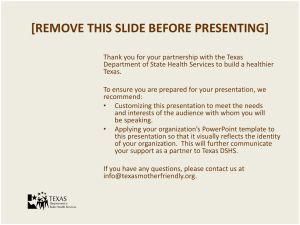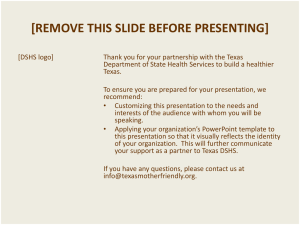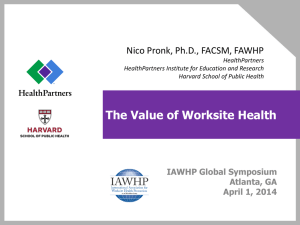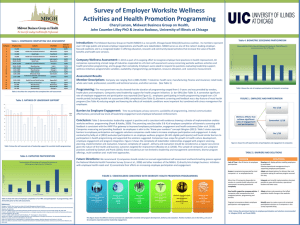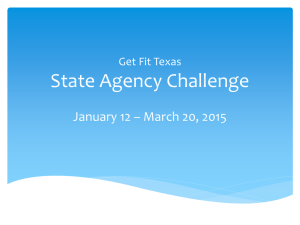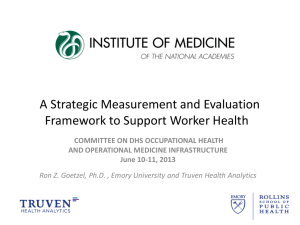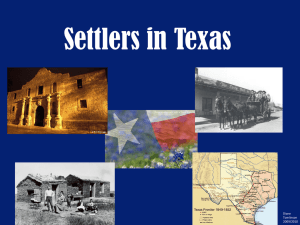PPT 14.01 MB - Mother
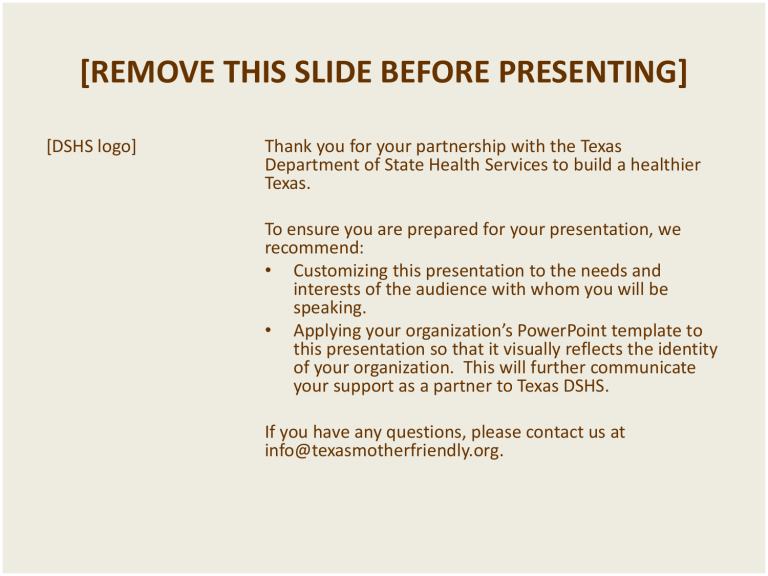
[REMOVE THIS SLIDE BEFORE PRESENTING]
[DSHS logo] Thank you for your partnership with the Texas
Department of State Health Services to build a healthier
Texas.
To ensure you are prepared for your presentation, we recommend:
• Customizing this presentation to the needs and interests of the audience with whom you will be speaking.
• Applying your organization’s PowerPoint template to this presentation so that it visually reflects the identity of your organization. This will further communicate your support as a partner to Texas DSHS.
If you have any questions, please contact us at info@texasmotherfriendly.org.
[Presenter Name]
[Presenter’s title or one-sentence bio]
Texas Mother-Friendly Worksite
Designation
Policy Development
Steps in Texas Mother-Friendly
Worksite Designation
• Seek executive-level support.
• Create, orient, and engage committee.
• Conduct a worksite needs assessment.
• Weigh needs, options, resources, and constraints and develop a designation plan.
• Develop and implement components to create a supportive environment.
• Track initiative indicators and evaluate outcomes on an ongoing basis.
Comprehensive Lactation
Support
Behavior
Information Education Communication
Environment
Private non-bathroom space
Storage alternatives
Access to water source
Policy
Flexible return to work
Flexible work schedules
Supportive supervisors
Creating a Culture of
Breastfeeding Support
Mother-Friendly Policy
• A key component that contributes to creating a supportive environment (culture change)
• Other necessary components of creating a supportive environment are:
• Friendly facilities
• Managerial and executive support/modeling
• Initial and ongoing promotion and publicity of program
• Peer modeling
Potential Policy Components
Statewide Wellness Plan:
Building Healthy Texans
http://www.wellness.state.tx.us/
Recommendations to Improve Support for
Breastfeeding Mothers:
• Provide a private, comfortable room for breastfeeding women to express milk during the workday.
• Develop a worksite breastfeeding support policy that meets or exceeds the DSHS Texas Mother-Friendly
Worksite Program minimum criteria.
•
Allow alternative work schedules or telecommuting for new mothers during their return to work.
Statewide Wellness Plan:
Building Healthy Texans
• Provide prenatal education, including breastfeeding education to women who work.
• Allow flexible scheduling to better accommodate breastmilk expression during the work day.
• Provide educational sessions, messages, and resources addressing benefits of breastfeeding and available lactation support.
• Provide child care on or near the worksite.
Texas Health and Safety
Code 165: Breastfeeding
• The legislature finds that breastfeeding a baby is an important and basic act of nurture that must be encouraged in the interests of maternal and child health and family values.
• The legislature recognizes a mother's responsibility to both her job and her child when she returns to work and acknowledges that a woman's choice to breastfeed benefits the family, the employer, and society.
Texas Mother-Friendly Worksite
Texas Mother-Friendly Worksite
Designation Criteria
Minimum standards for Texas Mother-Friendly Worksite designation:
•
Adheres to the definition of a Texas Mother-Friendly
Worksite: The worksite actively promotes and supports breastfeeding by its employees and maintains a written and communicated worksite lactation support policy.
•
Provides flexible scheduling and work patterns to allow time for the expression of breastmilk each time an employee has this need at least one year after the child’s birth.
•
Provides an accessible, private space, other than a bathroom, free from view and intrusion, for the expression of breastmilk.
•
Has an accessible, clean, safe water source and access to a hygienic place to store expressed breastmilk.
TexasMotherFriendly.org
Texas Mother-Friendly Worksite
Designation
•
•
•
•
•
Silver or Gold-Level Designation Criteria:
Meets minimum standards.
Provides dedicated lactation room.
Provides lactation room amenities.
Has a written policy in place for specific additional flexible scheduling options or provisions for keeping baby close during workday.
Provides educational/support resources.
TexasMotherFriendly.org
POLICY 101
A Policy is Needed When…
1
• The actions of employees indicate confusion about the most appropriate way to behave.
• Guidance is needed about the most suitable way to handle various situations.
• Having a policy will protect the business legally.
• Having a policy will assure compliance with government policies and laws.
• Establishing consistent work standards, rules, and regulations.
• Providing consistent and fair treatment to all employees.
What is a Policy?
• A policy is a set of rules that govern the implementation of processes in the workplace.
• Procedures, on the other hand, are the guidelines for how implementation of the policy should be carried out.
• Contingencies to the rule should be addressed in procedures (e.g., what if an employee is abusing the policy?)
Steps 1-4 of Policy Development
1
1. Clearly articulate the goal you hope to accomplish with the policy (after assessment, during planning).
2. Gather information (e.g., legal requirements, best practice guidance, various sample policies, legal consultation).
3. Develop and write the policy.
4. Review the policy – many eyes, varied perspectives (committee).
Steps 5-10 of Policy Development
1
5. Gain management support for the policy – buy-in and ownership (committee).
6. Consider gaining legal review of the policy if the policy has legal implications.
7. Communicate and implement the policy.
8. Decide how policy will be communicated in the future.
9. Interpret and integrate the policy – be consistent and fair.
10. Review policy (tracking and evaluation).
Characteristics of a Good Policy
2
• Written in clear, concise, simple language.
• Addresses what is the rule rather than how to implement the rule.
• Readily available with clear authority.
• Policy “ experts ” are available for assistance with interpretation.
• Consistent (does not conflict) with other policies.
Characteristics of a Good
Procedure
2
• Tied to policies; is consistent with policy goals and program plan.
• Developed with customer use in mind, providing benefits to the procedure user.
• Sense of ownership among procedure users
(developed with their input).
• Understandable, clear, and concise.
• Should offer options—restrictive procedures have limited usefulness.
Writing Style for Policies and
Procedures
2
• Concise, minimum amount of verbiage.
• Factual – double-check accuracy!
• Don’t include information that may be quickly outdated
(e.g., names).
• If you use an acronym, spell it out the first time you use it.
• Include step-by-step instructions for completing paper or electronic forms (procedures only).
• Not too technical – simple enough to be understood by a new employee.
Texas Mother-Friendly Worksite
Policy
• Define purpose of policy and state your organization’s support for breastfeeding.
• Describe, in general terms, the provisions of time, space, running water, hygienic storage alternatives, and other provided program components.
• May include manager and employee responsibilities.
• May refer to other policies associated with this policy (flextime, wellness, etc.).
TexasMotherFriendly.org
Policy Components
• Statement of purpose.
• Atmosphere of tolerance/atmosphere of support.
• Notification of policy to all employees.
• Time and leave.
• Facilities, including access to water and storage.
• Education/support/resources.
TexasMotherFriendly.org
References
1. Heathfield SM. How to develop a policy. About.com Human Resources. Available from: http://humanresources.about.com/od/policiesandsamples1/a/how_to_policy.htm
1. Policies and Procedures Team, UC Santa Cruz. Guide to Writing Policy and
Procedure Documents. 1994. Available from: http://www1.ucsc.edu/ppmanual/pdf/guide.pdf
TexasMotherFriendly.org
